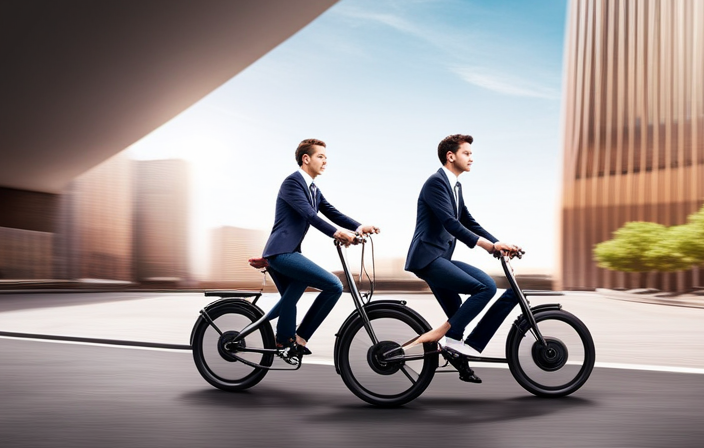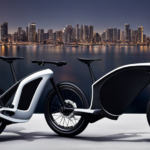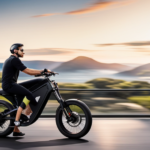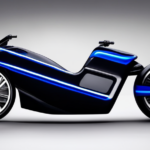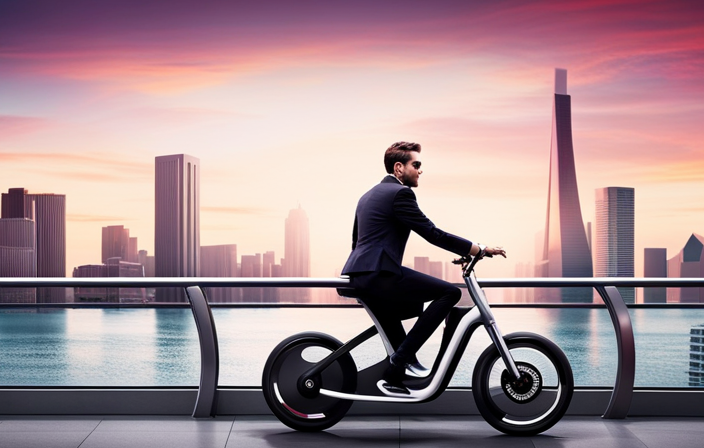As I zipped through the city streets, effortlessly gliding past traffic, I couldn’t help but marvel at the convenience and speed of my electric bike. Electric bikes, or e-bikes, have revolutionized the way we commute and enjoy the outdoors.
With their powerful electric motors and sleek design, these bikes provide an eco-friendly alternative to traditional bicycles. In this article, we will explore the components of an electric bike, the benefits of riding one, and how to choose the perfect e-bike for your needs.
Get ready to embark on a thrilling ride into the world of electric bikes!
Key Takeaways
- Regularly charge your electric bike after each use to maintain its functionality.
- Consider your riding needs, terrain, and distance when choosing the right electric bike.
- Assess motor power, battery capacity, suspension, and tires for optimal performance.
- Safety is a top priority when riding an electric bike, so wear a helmet, familiarize yourself with bike controls, use hand signals, and regularly check brakes, tires, and lights for safety.
Components of an Electric Bike
Now let’s talk about the components of an electric bike.
Electric bike technology has come a long way in recent years, and understanding the different parts that make up an electric bike is essential.
One of the main components is the battery, which provides the power to the motor. These batteries are usually lithium-ion and can be easily recharged.
Another crucial component is the motor, which is responsible for providing the assistance when pedaling. Electric bikes typically have a variety of motor options, including hub motors and mid-drive motors.
Other components include the controller, which regulates the power flow, and the display, which shows important information like battery level and speed.
Understanding the advantages of electric bikes, such as increased range and reduced effort while riding, will transition us into the subsequent section about the benefits of riding an electric bike.
Benefits of Riding an Electric Bike
Take advantage of the benefits of riding an e-bike. Not only does it provide a fun and efficient mode of transportation, but it also offers numerous advantages for your health and the environment. Here are some key benefits to consider:
-
Improved fitness: Riding an e-bike still requires pedaling, providing a moderate level of exercise that can help improve cardiovascular health and strengthen muscles.
-
Reduced impact on joints: The electric assistance can alleviate strain on joints, making it a suitable option for individuals with knee or joint pain.
-
Eco-friendly transportation: By opting for an electric bike instead of a car, you can significantly reduce your carbon footprint and contribute to a cleaner environment.
-
Cost-effective: Compared to traditional vehicles, e-bikes are more affordable to purchase and maintain, saving you money in the long run.
Now let’s delve into the different types of electric bikes.
Different Types of Electric Bikes
Let’s explore the various types of e-bikes available.
There are three main types of electric bikes: pedal-assist, throttle-assist, and speed pedelecs.
Pedal-assist e-bikes are the most common type, where the motor provides assistance when you pedal. These bikes have different levels of assistance that you can adjust according to your preference.
Throttle-assist e-bikes, on the other hand, have a throttle that allows you to control the motor without pedaling. This type is great for those who want a little extra boost without much effort.
Speed pedelecs are similar to pedal-assist e-bikes but can reach higher speeds of up to 28 miles per hour. They are ideal for commuters who need to cover longer distances quickly.
Each type of electric bike comes with its own unique features and advantages.
Now, let’s delve into how electric bikes work and understand their inner mechanisms.
How Electric Bikes Work
When it comes to how electric bikes work, there are a few key points to consider.
The first is the pedal-assist system, which uses a sensor to detect when you are pedaling and provides an extra boost of power.
Another option is the throttle-controlled system, which allows you to control the speed of the bike with a twist grip or thumb lever.
Additionally, electric bikes may have regenerative braking, which helps to recharge the battery while you are riding.
It’s also important to consider the range and battery life of an electric bike, as well as the charging and maintenance requirements.
Pedal-Assist System
The pedal-assist system on an electric bike provides an extra boost of power while you ride. This technology, also known as electric assist or pedelec, works by sensing your pedaling motion and providing assistance based on the level of force you apply. It’s like having a personal assistant that amplifies your pedaling power, making it easier to conquer hills and ride longer distances.
To give you a better idea of how the pedal-assist system works, let’s take a look at this table:
| Level | Pedal Force | Assistance Level |
|---|---|---|
| 1 | Light | Low |
| 2 | Moderate | Medium |
| 3 | Heavy | High |
As you can see, the assistance level increases as you apply more force to the pedals. This not only makes riding more enjoyable but also offers health benefits by encouraging physical activity.
Now, let’s move on to the next section and explore the throttle-controlled system.
Throttle-Controlled System
The previous subtopic discussed the Pedal-Assist System, which allows the rider to receive assistance from the electric motor while pedaling. Now, let’s delve into the Throttle-Controlled System. With this system, the rider can control the speed of the electric bike using a throttle, typically located on the handlebar. By simply twisting the throttle, you can engage the electric motor and propel the bike forward without the need for pedaling.
One of the benefits of throttle control is that it provides instant acceleration, making it easier to tackle steep hills or start from a standstill. Additionally, it allows riders with limited mobility or physical strength to enjoy the benefits of electric biking.
However, a limitation of throttle control is that it can drain the battery faster, as the motor is being engaged without any pedaling effort. It can also make the bike less efficient compared to the Pedal-Assist System.
Now, let’s transition into the subsequent section about ‘regenerative braking’ and explore its advantages and disadvantages.
Regenerative Braking
Regenerative braking allows riders to recharge the battery while slowing down or coming to a stop. It is a feature commonly found in electric bikes that harnesses the energy generated during braking and converts it into electrical energy, which is then stored in the battery for later use. This energy conversion process not only helps to extend the overall range of the electric bike but also improves its efficiency.
Here are five key points to understand about regenerative braking:
- It reduces the wear and tear on the bike’s mechanical braking system, making it last longer.
- The amount of energy regenerated depends on various factors such as the speed and weight of the bike, as well as the intensity of braking.
- The efficiency of regenerative braking varies between different electric bike models, so it’s important to choose one that offers optimal energy recovery.
- Regenerative braking can also provide a smoother and more controlled braking experience, enhancing rider safety.
- While regenerative braking is beneficial, it is important to note that it cannot fully recharge the battery, and additional charging is still required.
With a clear understanding of regenerative braking, let’s now delve into the topic of range and battery life.
Range and Battery Life
To maximize your riding experience, it’s important to understand the range and battery life of your electric bike. Range optimization is key when it comes to getting the most out of your electric bike.
Advances in battery technology have greatly improved the range of electric bikes in recent years. Lithium-ion batteries, for example, are now commonly used in electric bikes due to their high energy density and long lifespan. These batteries can provide a range of up to 100 miles on a single charge, depending on factors such as terrain and rider weight. Additionally, some electric bikes now offer the option to extend the range by adding an extra battery pack.
Understanding the range capabilities and taking advantage of the latest battery technology advancements will ensure that you can go the distance on your electric bike.
When it comes to charging and maintenance, there are a few simple steps you can take to keep your electric bike running smoothly.
Charging and Maintenance
Make sure you regularly charge and maintain your electric bike to keep it in optimal condition. Charging an electric bike is simple and similar to charging any other electronic device. Most electric bikes come with a removable battery that can be charged using a standard electrical outlet.
It is recommended to charge your bike after each use, especially if you have used up a significant amount of battery power. This will ensure that your bike is always ready to go when you need it.
In terms of maintenance, keeping your electric bike clean and lubricated is important. Regularly check and tighten the bolts and screws, and inspect the brake pads and tires for wear and tear.
By following these simple practices, you can prolong the lifespan of your electric bike.
Now, let’s move on to choosing the right electric bike for you.
Choosing the Right Electric Bike for You
When choosing the right electric bike for me, I need to consider my riding needs. This includes the distance I plan to travel and the terrain I will encounter.
It is also important to take into account the frame size and style that will provide the most comfortable and efficient ride.
Additionally, motor power and battery capacity, as well as suspension and tires, should be carefully evaluated to ensure optimal performance.
Lastly, price and warranty are important factors to consider. These factors ensure that I am getting the best value for my investment.
Consider Your Riding Needs
Consider your riding needs and determine if an electric bike would be suitable for you. Here are four factors to consider when choosing an electric bike based on your riding terrain and budget considerations:
-
Terrain: Think about the type of terrain you will be riding on. If you plan on tackling steep hills or rough off-road trails, you may want to consider an electric mountain bike with a powerful motor and sturdy suspension. For urban commuting or leisurely rides on flat surfaces, a city e-bike or a hybrid model might be more appropriate.
-
Budget: Determine how much you are willing to spend on an electric bike. Prices can vary greatly depending on the brand, features, and quality. It’s important to find a balance between your budget and the desired specifications of the bike.
-
Range: Consider the distance you will be riding on a single charge. Electric bikes have different battery capacities, which affect their range. If you plan on long rides, look for a bike with a larger battery capacity to ensure you won’t run out of power mid-ride.
-
Weight: Take into account the weight of the electric bike. Heavier models may be more stable and sturdy, but they can also be harder to maneuver, especially if you need to carry the bike upstairs or load it onto a vehicle.
Considering these factors will help you make an informed decision about the right electric bike for your needs.
When you have determined the specifications that suit you, it’s time to move on to the next section about frame size and style, ensuring a comfortable and stylish ride.
Frame Size and Style
Determining the right frame size and style is crucial for a comfortable and stylish ride. When choosing an electric bike, it’s important to consider the frame material that suits your needs. Common materials include aluminum, steel, and carbon fiber, each offering different advantages in terms of weight, durability, and cost. Additionally, selecting the right frame size is essential for optimal comfort and efficiency. A frame that is too small or too large can result in discomfort and may affect your riding performance. To help you find the perfect fit, refer to the manufacturer’s size guide or consult with a professional at a bike shop. Remember, a well-fitting frame will ensure an enjoyable and safe ride. Now, let’s delve into the next section about motor power and battery capacity to further enhance your understanding of electric bikes.
Motor Power and Battery Capacity
The motor power and battery capacity are important factors to consider when choosing an electric bicycle. The motor power determines how fast the bike can go and how well it can handle inclines and rough terrain. A higher motor power will provide more assistance and a smoother ride.
The battery capacity, on the other hand, determines how far you can ride before needing to recharge. It is crucial to choose a battery with enough capacity to meet your daily commuting needs or leisure rides. Consider factors such as your weight, the terrain you’ll be riding on, and the distance you plan to cover. A longer battery life ensures that you won’t run out of power in the middle of your ride.
Moving on to the next section about suspension and tires, it is important to find the right balance for a comfortable and stable ride.
Suspension and Tires
When choosing an e-bike, it’s important to find the right balance for a comfortable and stable ride, and this includes considering the suspension and tires. The suspension system plays a crucial role in absorbing shocks and providing a smooth ride, especially when riding on uneven terrains. There are two main types of suspension systems commonly found in electric bikes: front suspension and full suspension. Front suspension, as the name suggests, only has suspension on the front wheel, while full suspension bikes have suspension on both the front and rear wheels. This ensures better control and reduces the impact on your body. Additionally, the type of tires you choose can greatly affect your riding experience. Different tire types, such as slick tires or knobby tires, are designed for specific terrains like pavement or off-road trails, respectively. By choosing the right suspension system and tires, you can enhance your comfort and confidence while riding your e-bike. Moving on to the next section, let’s discuss the important factors of price and warranty.
Price and Warranty
Finding the right balance between cost and warranty is essential when considering an e-bike purchase. Electric bikes can vary greatly in price, ranging from a few hundred dollars to several thousand. It’s important to do a price comparison and determine what features and specifications are worth the extra cost.
Additionally, it’s crucial to inquire about extended warranty options. Some manufacturers offer extended warranties that provide coverage beyond the standard warranty period, giving you peace of mind and potentially saving you money on repairs in the long run.
When riding an electric bike, safety should always be a top priority. So, let’s delve into some tips for riding an electric bike safely.
Tips for Riding an Electric Bike Safely
To ride an electric bike safely, you should always wear a helmet. It is essential to protect your head in case of accidents.
In addition to wearing a helmet, there are a few riding techniques and proper gear that can enhance your safety. Firstly, it is crucial to familiarize yourself with the bike’s controls and understand how to properly operate it. Practice starting and stopping smoothly to maintain balance.
When riding, always be aware of your surroundings and use hand signals to communicate your intentions to other road users. It is also recommended to wear brightly colored clothing or reflective gear to increase your visibility.
Lastly, make sure to check your bike’s brakes, tires, and lights regularly to ensure they are in good working condition.
By following these tips, you can enjoy a safe and pleasant electric bike ride.
Frequently Asked Questions
What are the regulations and laws regarding riding an electric bike?
Regulations and laws regarding riding an electric bike vary depending on the country and region. In many places, electric bikes are treated similar to regular bicycles, but they may have speed limits and require helmets. While they offer benefits like eco-friendliness and convenience, drawbacks include limited range and higher initial cost.
How long does the battery of an electric bike typically last?
The battery lifespan of an electric bike typically lasts between 2-5 years, depending on usage and maintenance. Charging frequency also affects battery life, with daily charging leading to shorter overall lifespan.
Can I ride an electric bike in the rain?
Yes, you can ride an electric bike in the rain. Electric bikes are designed to withstand various riding conditions, including rain. They often come with waterproofing technology to protect the electrical components and ensure safe operation.
Are electric bikes suitable for uphill or off-road riding?
Electric bikes are perfect for uphill challenges and off-road obstacles. With their powerful motors and sturdy frames, they provide the necessary assistance and durability to conquer any terrain.
How do I maintain and service an electric bike?
To maintain an electric bike, I recommend regular maintenance such as cleaning, lubricating the chain, and checking tire pressure. Additionally, it’s important to service the battery, motor, and brakes annually to ensure optimal performance and longevity.
Conclusion
In conclusion, electric bikes are an incredible mode of transportation that have revolutionized the way we travel.
From their powerful motors to their sleek designs, these bikes offer a convenient and eco-friendly way to get around town.
Whether you’re a commuter looking to beat the traffic or a nature enthusiast seeking a thrilling adventure, an electric bike is the perfect companion.
So hop on your e-bike and let the future take you for a ride. You’ll be zipping through the streets with a smile on your face in no time.
